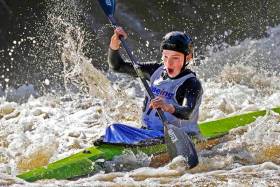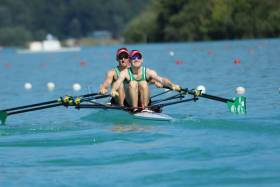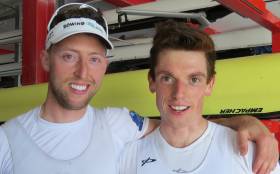Displaying items by tag: World Cup
#Canoeing: Ronan Foley took gold medals on Saturday and Sunday at the canoe marathon World Cup in in Viana do Castelo in Portugal. The Kilcullen man dominated the short race on Saturday, and then sprinted away from his rivals on the last portage to win the marathon test on the Sunday.
Barry Watkins took silver in the senior race over the short course on Saturday and took 10th on Sunday – recovering from an unwanted swim in rough conditions.
Canoe Marathon World Cup, Viana Do Castelo, Portugal (Irish interest; selected results):
Saturday
Men – K1 Short Race: 2 B Watkins 13:46.15.
K1 Short Race, Juniors: 1 R Foley 14 min 52.43 sec.
Sunday
Men – K1 Marathon: 10 Watkins 2 hr 21 min 10.20.
K1 Marathon, Junior Final: 1 Foley 1 hr 53 min 7.34 sec.
Bronze for O'Donovans at World Cup Rowing in Lucerne
#Rowing: Ireland’s Paul and Gary O’Donovan took bronze at the World Cup Regatta in Lucerne today. Olympic champions France, as has been the pattern this season, took the lead early and never relinquished it. Italy chased them all the way and took silver.
The Ireland lightweight double was in touch from early on and established themselves firmly in third coming to the line, ahead of Belgium and Greece.
World Cup Regatta, Lucerne, Day Three (Irish interest)
Men
Lightweight Double Sculls – A Final: 1 France 6:12.96, 2 Italy 6:15.43, 3 Ireland (G O’Donovan, P O’Donovan) 6:18.15; 4 Belgium 6:19.30, 5 Greece 6:19.95, 6 Czech Republic 6:21.34.
Women
Quadruple Sculls – A Final: 5 Britain (3 H Nixon) 6:29.50.
Single Sculls – B Final: 1 Ukraine 7:39.55, 2 New Zealand 7:41.55, 3 Ireland One (S Puspure) 7:42.23, 4 Denmark One 7:42.26, 5 Belarus 7:42.89, 6 Ireland Two (M Dukarska) 7:56.07.
Puspure Takes Third in B Final at Lucerne Rowing
#Rowing: Sanita Puspure took third in the B Final of the women’s single sculls at the World Cup Regatta in Lucerne, ninth overall, while Monika Dukarska was three places further back, in sixth (12th overall). Puspure was part of a five-boat sprint finish, and she showed good speed to finish ahead of Fie-Udby Erichsen of Denmark and Ekaterina Karsten of Belarus. Ahead of her was winner Diana Dymchenko of Ukraine and Hannah Osborne of New Zealand. Dukarska, who had started well, had fallen a few lengths off this leading group by the finish.
World Cup Regatta, Lucerne, Day Three (Irish interest)
Women
Single Sculls – B Final: 1 Ukraine 7:39.55, 2 New Zealand 7:41.55, 3 Ireland One (S Puspure) 7:42.23, 4 Denmark One 7:42.26, 5 Belarus 7:42.89, 6 Ireland Two (M Dukarska) 7:56.07.
#Rowing: Shane O’Driscoll and Mark O’Donovan won the A Final of the lightweight pair at the World Cup in Lucerne today. They swept past early leaders Britain in the third quarter and won well. Russia showed surprising pace late on to take silver, while Brazil took the bronze, ahead of Britain’s Sam Scrimgeour and Joel Cassells.
O’Driscoll and O’Donovan won World Cup gold in Belgrade and Poznan and are European champions thanks to their win in Racice.
World Cup Regatta, Lucerne – Day Two (Irish interest)
Men
Lightweight Pair – A Final: 1 Ireland (M O’Donovan, S O’Driscoll) 6:34.00, 2 Russia 6:36.28, 3 Brazil 6:37.50; 4 Britain 6:38.84, 5 France 6:45.94, 6 Norway 6:58.68.
Lightweight Double Sculls – Semi-Finals (First Three to A Final; rest to B Final) – Semi Final One: 1 France 6:20.57, 2 Belgium 6:24.68, 3 Greece 6:26.92.
Semi Final Two: 1 Italy 6:20.82, 2 Czech Republic 6:22.05, 3 Ireland (G O’Donovan, P O’Donovan) 6:23.75; 4 Britain 6:25.25, 5 Japan Two 6:27.84, 6 Russia 6:34.33.
Women
Single Sculls Semi-Finals (First Three to A Final; rest to B Final) – Semi Final One: 1 Austria (M Lobnig) 7:35.06, 2 Germany (A Thiele) 7:35.96, 3 Britain (V Thornley) 7:36.09; 4 Ireland One (S Puspure) 7:36.90; 6 Ireland Two (M Dukarska) 7:55.0.
O'Donovans Qualify for A Final at Lucerne World Cup
#Rowing: Paul and Gary O’Donovan qualified for the A Final of their fourth major regatta this season when they finished third in their semi-final at the World Cup in Lucerne. They reached the top stage in World Cup regattas in Belgrade and Poznan and at the European Championships.
Italy took the risky strategy of setting off very fast in the hope of leading all the way. It worked, and they won. The Czech Republic, Ireland and Russia were their main rivals until the final quarter, when, as the Russians faded in the hot conditions, the Czechs and Ireland nailed down the second and third spots. Britain’s Jamie Copus and Sam Mottram pushed to pass Ireland but could not.
World Cup Regatta, Lucerne – Day Two (Irish interest)
Men
Lightweight Double Sculls – Semi-Finals (First Three to A Final; rest to B Final) – Semi Final One: 1 France 6:20.57, 2 Belgium 6:24.68, 3 Greece 6:26.92.
Semi Final Two: 1 Italy 6:20.82, 2 Czech Republic 6:22.05, 3 Ireland (G O’Donovan, P O’Donovan) 6:23.75; 4 Britain 6:25.25, 5 Japan Two 6:27.84, 6 Russia 6:34.33.
Women
Single Sculls Semi-Finals (First Three to A Final; rest to B Final) – Semi Final One: 1 Austria (M Lobnig) 7:35.06, 2 Germany (A Thiele) 7:35.96, 3 Britain (V Thornley) 7:36.09; 4 Ireland One (S Puspure) 7:36.90; 6 Ireland Two (M Dukarska) 7:55.0.
Puspure So Close to A Final Place in Lucerne World Cup
#Rowing: Ireland’s Sanita Puspure and Monika Dukarska finished fourth and sixth in their semi-final today and will take part in the B Final at the World Cup Regatta in Lucerne. Magdalena Lobnig of Austria, Annekatrin Thiele of Germany and Vicky Thornley of Britain took the qualifying places, in that order, but Puspure was finishing fast and came within a second of overtaking Thornley, who just held on to that vital third place.
World Cup Regatta, Lucerne – Day Two (Irish interest)
Women
Single Sculls Semi-Finals (First Three to A Final; rest to B Final) – Semi Final One: 1 Austria (M Lobnig) 7:35.06, 2 Germany (A Thiele) 7:35.96, 3 Britain (V Thornley) 7:36.09; 4
Ireland One (S Puspure) 7:36.90; 6 Ireland Two (M Dukarska) 7:55.0.
#Rowing: Paul O’Donovan and Gary O’Donovan won their repechage to qualify for the semi-finals of the lightweight double sculls at the World Cup Regatta in Lucerne today. The Skibbereen men had not intended to be in the race – run in very hot conditions – but they judged it well, taking out both Russia and Denmark in the final 200 metres.
World Cup Regatta, Lucerne, Day One (Irish interest)
Men
Lightweight Pair – Exhibition Race: 1 Britain (J Cassells, S Scrimgeour) 6:57.32, 2 Ireland (M O’Donovan, S O’Driscoll) 6:59.26, 3 Brazil 6:59.29.
Lightweight Double Sculls (First Two to A/B Semi-Finals; rest to Repechage) – Heat One: 1 France 6:27.36, 2 Britain One 6:30.70. Heat Two: 1 Greece 6:25.88, 2 Czech Republic 6:26.39; 3 Ireland (G O’Donovan, P O’Donovan) 6:28.63. Heat Three: 1 Italy 6:29.15, 2 Belgium 6:32.44.
Repechage One (First Three to A/B Semi-Final; rest to C Final): 1 Ireland 6:44.33, 2 Denmark 6:45.71, 3 Russia 6:45.91.
Women
Single Sculls (Three to Quarter-Finals; rest to quarters or E Final) – Heat Three: 1 Austria (M Lobnig) 7:46.97, 2 Ireland Two (M Dukarska) 7:51.44, 3 Latvia (E Gulbe) 8:02.20.
Heat Five: 1 Britain (V Thornley) 7:45.65, 2 Ireland One (S Puspure) 7:47.84, 3 Finland (E Karppinen) 7:58.04.
Quarter-Finals (First Three to A/B Semi-Finals): QF One: 1 Ireland (Puspure) 7:52.50, 2 United States (F Mueller) 7:53.39,
3 Belarus (E Karsten) 7:59.13.
QF Three: 1 Canada (C Zeeman) 7:57.04, 2 Germany (A Thiele) 8:01.51, 3 Ireland (Dukarska) 8:03.64.
#Rowing: Both of Ireland’s competitors made the semi-finals of the women’s single sculls at the World Cup in Lucerne. Sanita Puspure won her quarter-final, while Monika Dukarska took a comfortable third in hers.
Puspure had tough opponents. She battled it out with Felice Mueller of the United States and Ekaterina Karsten of Belarus throughout. They moved away from the rest of the field and though all three were all but guaranteed to take the qualification places, Puspure finished impressively to win.
Dukarska’s third was a clear one. Again, three women broke free. Carling Zeeman took over to win, with Annekatrin Thiele of Germany second and Dukarska not far behind – over 11 seconds clear of Eeva Karppinen of Finland in fourth.
World Cup Regatta, Lucerne, Day One (Irish interest)
Men
Lightweight Pair – Exhibition Race: 1 Britain (J Cassells, S Scrimgeour) 6:57.32, 2 Ireland (M O’Donovan, S O’Driscoll) 6:59.26, 3 Brazil 6:59.29.
Lightweight Double Sculls (First Two to A/B Semi-Finals; rest to Repechage) – Heat One: 1 France 6:27.36, 2 Britain One 6:30.70. Heat Two: 1 Greece 6:25.88, 2 Czech Republic 6:26.39; 3 Ireland (G O’Donovan, P O’Donovan) 6:28.63. Heat Three: 1 Italy 6:29.15, 2 Belgium 6:32.44.
Women
Single Sculls (Three to Quarter-Finals; rest to quarters or E Final) – Heat Three: 1 Austria (M Lobnig) 7:46.97, 2 Ireland Two (M Dukarska) 7:51.44, 3 Latvia (E Gulbe) 8:02.20.
Heat Five: 1 Britain (V Thornley) 7:45.65, 2 Ireland One (S Puspure) 7:47.84, 3 Finland (E Karppinen) 7:58.04.
Quarter-Finals (First Three to A/B Semi-Finals): QF One: 1 Ireland (Puspure) 7:52.50, 2 United States (F Mueller) 7:53.39,
3 Belarus (E Karsten) 7:59.13.
QF Three: 1 Canada (C Zeeman) 7:57.04, 2 Germany (A Thiele) 8:01.51, 3 Ireland (Dukarska) 8:03.64.
#Rowing: Shane O’Driscoll and Mark O’Donovan finished well to take second in their lightweight pair exhibition race at the World Cup regatta in Lucerne today. Britain’s Joel Cassells and Sam Scrimgeour took over at the head of the field Ireland crew early on and stayed there despite pushes by Brazil and Ireland. The South American crew looked to have taken second coming up to the line, but O’Driscoll and O’Donovan snatched it from them by three hundredths of a second.
The Final is on tomorrow, Saturday.
World Cup Regatta, Lucerne, Day One (Irish interest)
Men
Lightweight Pair – Exhibition Race: 1 Britain (J Cassells, S Scrimgeour) 6:57.32, 2 Ireland (M O’Donovan, S O’Driscoll) 6:59.26, 3 Brazil 6:59.29.
Lightweight Double Sculls (First Two to A/B Semi-Finals; rest to Repechage) – Heat One: 1 France 6:27.36, 2 Britain One 6:30.70. Heat Two: 1 Greece 6:25.88, 2 Czech Republic 6:26.39; 3 Ireland (G O’Donovan, P O’Donovan) 6:28.63. Heat Three: 1 Italy 6:29.15, 2 Belgium 6:32.44.
Women
Single Sculls (Three to Quarter-Finals; rest to quarters or E Final) – Heat Three: 1 Austria (M Lobnig) 7:46.97, 2 Ireland Two (M Dukarska) 7:51.44, 3 Latvia (E Gulbe) 8:02.20.
Heat Five: 1 Britain (V Thornley) 7:45.65, 2 Ireland One (S Puspure) 7:47.84, 3 Finland (E Karppinen) 7:58.04.
#Rowing: Ireland’s Paul O’Donovan and Gary O’Donovan finished third in their heat and must come through a repechage if they are to qualify for the semi-finals of the lightweight double sculls at the World Cup Regatta in Lucerne.
Just two crews qualified directly and the Ireland crew trailed Greece and the Czech Republic through the four quarters of the race. With 250 metres to go the men in green looked set to take out at least one of the two, but both powered on and Ireland, stuck in third, faded back coming up to the line.
World Cup Regatta, Lucerne, Day One (Irish interest)
Men
Lightweight Double Sculls (First Two to A/B Semi-Finals; rest to Repechage) – Heat One: 1 France 6:27.36, 2 Britain One 6:30.70.
Heat Two: 1 Greece 6:25.88, 2 Czech Republic 6:26.39; 3 Ireland (G O’Donovan, P O’Donovan) 6:28.63.
Heat Three: 1 Italy 6:29.15, 2 Belgium 6:32.44.
Women
Single Sculls (Three to Quarter-Finals; rest to quarters or E Final) – Heat Three: 1 Austria (M Lobnig) 7:46.97, 2 Ireland Two (M Dukarska) 7:51.44, 3 Latvia (E Gulbe) 8:02.20.
Heat Five: 1 Britain (V Thornley) 7:45.65, 2 Ireland One (S Puspure) 7:47.84, 3 Finland (E Karppinen) 7:58.04.


































































